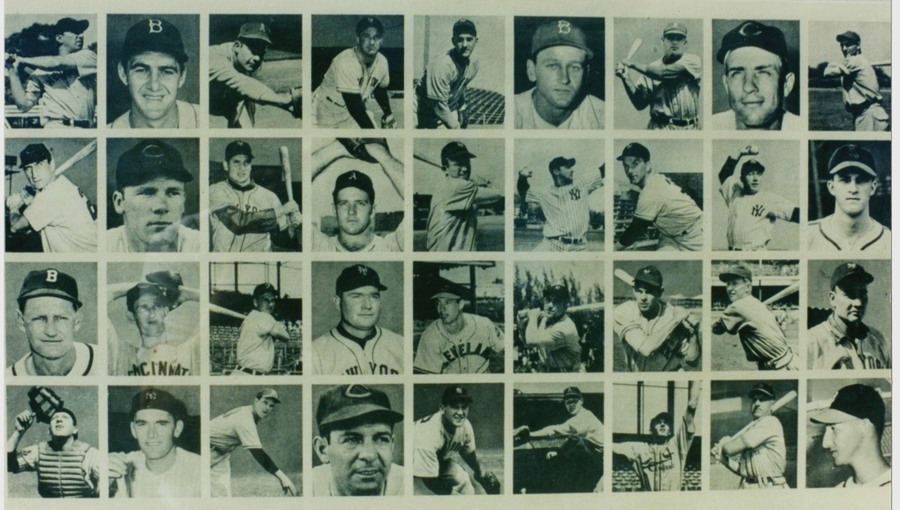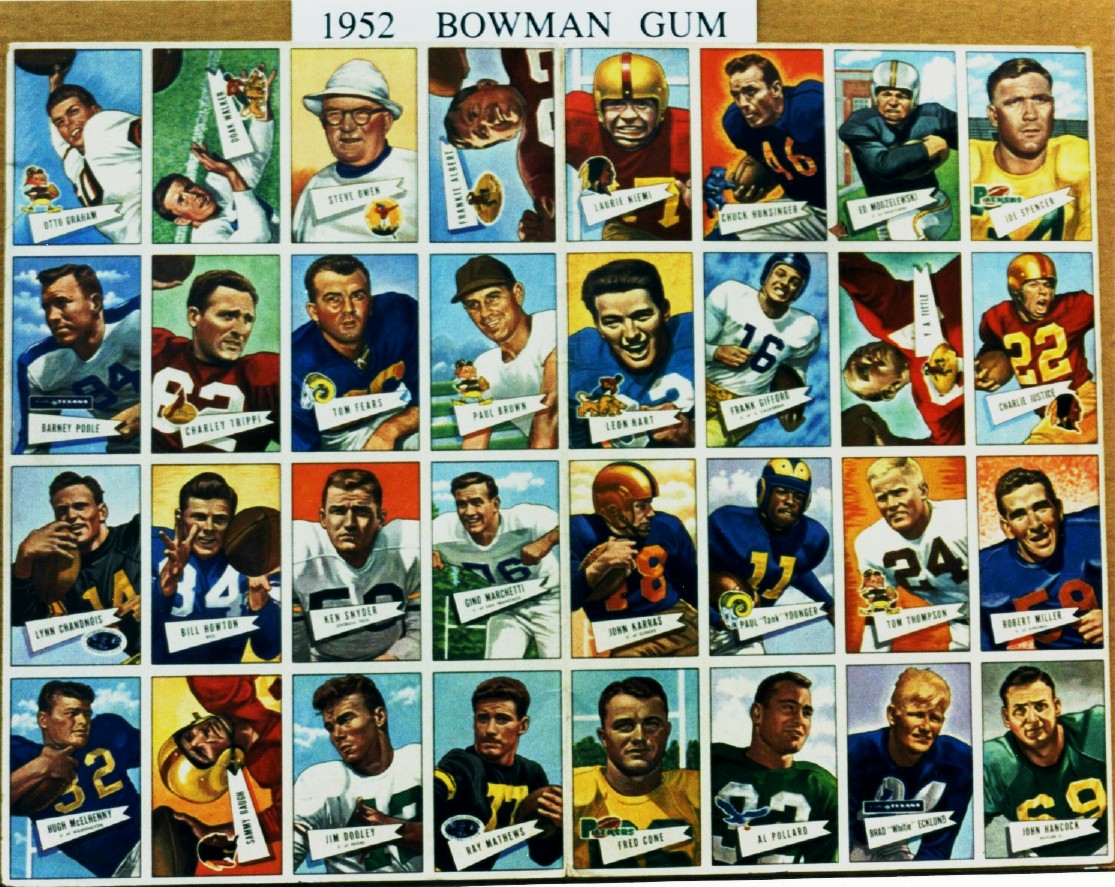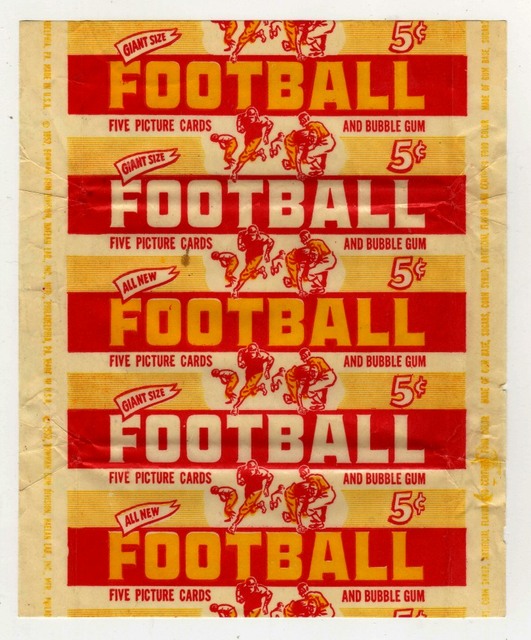|
|
#1
|
|||
|
|||
|
The Bowmans are one of my favorite vintage baseball runs, with a very minimalist design until the final year. I would hardly consider myself any kind of expert on these, but Ive been collecting them for most of my life and would love to flesh out the details. For, frankly, no real reason at all I like to separate my sets by series, recreating how they were actually issued in my boxes. This poses a challenge for the Bowmans, as there seems to be little direct evidence of most of the series. The uncut sheets of the 48s and 49s dont seem to exist in the other years (or if they do, are seldom seen/shared). Below is the series by series breakdown for every year, as I understand it. A lot of this seems to fall into the common wisdom category of information that is listed in the articles and guides and makes logical sense, but doesnt seem to have a source of direct evidence that I can locate to prove the assertion. Id love to hear anyone elses thoughts, theories, corrections, direct evidence (anyone opened a pack of 53-55 to help ID what numbers were in a series?), uncut material, or anything else.
1948 Bowman 1 series or 2? Two sheets were used, one with cards 1-36, and a second sheet removing cards 7, 8, 13, 16, 20, 22, 24, 26, 28, 29, 30 and adding 37-48. Two sheets doesnt necessarily mean two series though. 1949 Bowman Series 1: 1-3, 5-73. Printed on two sheets, but these appear to have been issued as one series. Gray or white backs for all cards. Series 2: 4, 74-108. Gray backs only from here on out. Series 3: 109-144. The printed names on back were printed in script instead, and the players name was added to the front of the cards. Series 4: 145-180. The name on front is kept, but the backs reverted to a printed name instead of cursive script. This series is the beginning of the high numbers. Series 5: 181-216, same format as series 4. Series 6: 217-240, plus reprints of 4, 78, 83, 85, 88, 98, 109, 124, 126, 127, 132 and 143. These 12 reprinted cards created variations with how the names are printed on the back, are or are not on the front, and the background color of some of the cards. Pacific Coast League issue of 36 cards, a single sheet. 1950 Bowman Series 1: 1-72 - again, it appears that the first two sheets were issued as one series. Tougher than the rest of the series, but not particularly difficult Series 2: 73-108 Series 3: 109-144 Series 4: 145-180 Series 5: 181-216. Cards can be found with or without the copyright caption on back. Cards missing it are scarcer, and are much tougher to find than the missing caption cards in series 6 Series 6: 217-252 1951 Bowman Series 1: 1-36 Series 2: 37-72 Series 3: 73-108 Series 4: 109-180. A two sheet series. Series 5: 181-216 Series 6: 217-252 Series 7: 253-324. A two sheet series, significantly tougher than the first 6 series. 1952 Bowman Series 1: 1-72. Again appears to have been issued as one series from two sheets. Each card can be found from two different printings, one with a creamer border and less vibrant color, and one with a whiter border and more vibrant colors. Series 2: 73-108 Series 3: 109-144 Series 4: 145-180 Series 5: 181-216 Series 6: 217-252. Notably more difficult than the earlier series 1953 Bowman This one is a total mystery to me. I would presume the sheet sizes changes with the great increase in the physical size of the cards. 160 cards in the color issue divides into 5 series of 32 cards, if Bowman kept this format. The cards are usually grouped into 3 chunks, 1-112 being the commons, 113-128 being short prints, and 129-160 being the rest of the higher numbers, but easier than 1-112. Personally, I did not find 113-128 to be more difficult than the other high number cards when I built my set. 113-160 constitutes 48 cards, so there may have been some short printing and double printing to place 48 cards onto 2 sheets for this series, account for the 16 cards 113-128 that have historically been treated different. I find it very unlikely 1-112 was one series, and was probably 4 32 card series, or 2 64 card ones. The Black and White set was issued after the Colors, and is the final series, even though the numbering starts over. Appears to have been a single issue. 1954 Bowman Another mystery to me. Traditionally grouped into two batches, 1-128 and 129-224. The second does seem to be a little bit scarcer than the first group, but is pretty easy for high numbers. I would suspect there are at least 2 series among the low numbers, though the high numbers may be 1, as Bowman seems to have switched to larger series for 1955, which could have begun here at the end of the 1954 run. 1955 Bowman Mystery again. Traditionally split into two groups, 1-224 being the more common low numbers and then 225-320 being the tougher highs. 225 definitely starts a new series, as the scarcity difference is quite obvious on the highs, though they arent that tough to find overall. The 224 low numbers divide into 32, unsurprisingly. The first 64 cards feature a light colored television set, and are often labelled as series 1. This does not seem to be case to me, as I have seen some miscuts that show the adjacent card to alight colored 1-64 card was a dark bordered TV card. It seems to me series 1 probably constituted at least 1-96. There were probably 2-4 series that make up the low numbers. The 96 high numbers may have been one series, as it appears Bowman switched to larger series in 1955. |
|
#2
|
|||
|
|||
|
Greg: Seems like a pretty accurate assessment of the Bowman output. Have you ever laid eyes on the excellent and highly detailed article that Ted Zanidakis did for Baseball Cards Magazine on the 1953 Bowman set back in the 1980's? It may have been posted here sometime in the past, but I don't have a link to it right now. If you can't find it, I have a copy of the BBC article in my files and can post it for your dining and dancing pleasure.

|
|
#3
|
|||
|
|||
|
Quote:
|
|
#4
|
||||
|
||||
|
This is an excellent thread.
I am currently trying to put together a complete 51' Bowman set. Prior to taking on this task, I laughed at the idea that the high numbers were more challenging to find. I used to think this whole thing was a marketing ploy. However, it has been a few months now since I've been working on this set and I realize that I was dead wrong.  High numbers really are tough. Whenever somebody lists a group of these cards for sale online, there probably won't be a single high in there. I also think that the PSA Population Report gives us the wrong idea, because we don't see a big difference between the highs and lows, however, that's only because collectors are more likely to submit a high in for grading. High numbers really are tough. Whenever somebody lists a group of these cards for sale online, there probably won't be a single high in there. I also think that the PSA Population Report gives us the wrong idea, because we don't see a big difference between the highs and lows, however, that's only because collectors are more likely to submit a high in for grading.
|
|
#5
|
|||
|
|||
|
Quote:
If you haven't come across it, there is an excellent article breaking down the probably printing date ranges based on the text of all the card backs and the teams players are credited too. I found this wonderfully helpful and interesting myself: https://www.pjdenterprises.com/baseb...man_print.html |
|
#6
|
||||
|
||||
|
Great Super Sleuth work on these Bowmans. My experience with collecting the 1950 set is that the first 36 cards are tougher than the next 36. It seems that nicer condition cards (EX-MT or better) #1-36 are harder to find. #73 on up are definitely easier.
|
|
#7
|
|||
|
|||
|
Quote:
Greg: Here is the Ted Z article from the 1986 issue of BBC Magazine. |
|
#8
|
|||
|
|||
|
Sorry these images are so dang hard to read. The system does not allow pages larger than 80 kb to post, which causes them to appear nearly illegible. If anyone knows a work around of that, please comment.
|
|
#9
|
|||
|
|||
|
I put my set together without any real regard for condition, and can't say I noticed a scarcity difference. Perhaps it was two series instead of 1, I'm not aware of any direct evidence that the first series was one of the 'double length' series Bowman issued occasionally. It seems to be a long standing assumption I have always heard, and the fact that the first 72 are notably tougher than 73-252 hints that it may have been the traditionally assigned single series. I would love to find out for sure, if anyone has a sheet or has opened a pack
|
|
#10
|
||||
|
||||
|
Quote:
|
|
#11
|
|||
|
|||
|
Quote:
I think this is partly the fault of how we see things today, focusing only on the major sports sets. Bowman and Topps printed (through a contracted printer) several sets throughout most years. Some of these appear to have been printed right around the same time. Football season coming doesn't appear to mean that they needed to cease production of one set to make another; and the drop in sales throughout a season does not seem to me to relate to football at all. I think the writer did a great job of identifying the earliest possible print dates based on a thorough examination of the cards, but of course, barring a find of Bowman's internal records, I'll doubt we'll ever know the actual ones. |
|
#12
|
|||
|
|||
|
G1911
Nice presentation. But, starting with the 1948 set, some of the info you stated regarding Series make-up of these BOWMAN sets is not correct.  TED Z T206 Reference . |
|
#13
|
|||
|
|||
|
Quote:
I'm confident some of it is not; it's taken mostly from articles, variations that can help pinpoint, the little uncut material I have seen previously, and the catalogs. What is incorrect with 1948? Was it not two sheets? Is it known if it was 1 or 2 series? |
|
#14
|
||||
|
||||
|
Hey Teddy Z, your uncut sheets remind me of something, You once (I believe many years ago) posted a big sheet of the 51 or 52 Bowman cards that was much bigger than the smaller ones normally seen. Do you still have that scan?
|
|
#15
|
|||
|
|||
|
Quote:
Hi Dave Great hearing from you. I missed seeing you at the National this past Summer. Is this the BOWMAN sheet you are referring to...   TED Z T206 Reference . |
|
#16
|
||||
|
||||
|
Ted, I've been to Chicago the last several Nationals and seem to be arriving when you are leaving. I probably will not be in AC this year.
No it was the smaller cards I think but was more like a Topps sized sheet; there were a number of 32 card groupings on it, maybe in a 4 x 3 array with gutters in between each 32 card panel. I may be misrembering if it was yours but I do recall it being posted here a long while back. I lost some scans in a hard drive crash awhile back and that was one of them. Only time I've ever seen something like that. Last edited by toppcat; 12-19-2019 at 08:27 AM. |
|
#17
|
||||
|
||||
|
Steve,
Thank you so much for posting this Zanidakis article. I couldn't read it on my desktop at first, but then I looked at the pages on my wife's iPad, with the brightness turned all the way up, and I managed to read the whole thing pretty quickly. It's an amazing piece of work and it answers so many of my questions. Did you actually read these baseball card magazines back in the 1980s? Are there any other interesting articles you have? If so, I would love to read them! Please PM me. ____________________________________________ G1911 (what's your name, dude?) I found this interesting paragraph in the Zanidakis article posted above: Usually, the later series were not printed or sold in as high a quantity as the first few series, because the novelty of the new set would have worn off by mid-summer OR the cards would be competing with football cards on the store shelves. Zanidakis has listed two possible explanations as to why Bowman would short-print their high numbers. This takes us back to my earlier question, and that is how early did Bowman start printing their football cards? Bowman started printing their baseball cards during the same month the 51' baseball season started, which was in April, but it looks like they did not do this with their football cards. In other words, Bowman issued their football cards way before the football season even started. |
|
#18
|
|||
|
|||
|
Quote:
Dave: Are the sheets at this link what you are referring to? https://www.footballcardgallery.com/...+Bowman+Large/ |
|
#19
|
|||
|
|||
|
Here is an old thread from nine years ago that has a lot of very salient information on the same subject.
http://www.net54baseball.com/showthread.php?t=120822 |
|
#20
|
|||
|
|||
|
Quote:
Going off memory - the 51 Bowman Footballs almost all have a "[Name] was on blank team/did [achievement] in 1950" and most of the rest of the text is about the few years before 1950, less of a 'live update' type approach that is on some of the baseball cards. I have near sets of the 54-55 Bowman and 56 Topps football issues I can scour the backs for to see latest/earliest possible dates. |
|
#21
|
||||
|
||||
|
Steve, thanks for the two links. The sheet I recall seeing isn't among either unfortunately. Probably not a Teddy Z post then, adding to the mystery. Well, I will keep digging.
|
|
#22
|
|||
|
|||
|
It should be possible to narrow down the 1955's using physical evidence, due to the change in border color starting at card 65, making even slight miscuts show the border type of the adjacent card.
Because there was a tiny 'margin of error' between miscut cards of a different color adjacent to each other, they are easy to find. Here are some of of the lower number cards showing dark brown TV borders to the left or right side (I don't believe I've seen one top or bottom). Minoso in particular seems to be very easy to find off center and showing this. Schoendienst is another one found this way, though my card is cut properly. I hope this shows up clearly, as this site's software caps image sizes at only a few percent of the original photo size. |
|
#23
|
|||
|
|||
|
The off-center cards in the light-colored numbers tell us that both color TV's were in that printing. Most likely, this would include at least 32 dark color TV cards, 65-96. However, going through my set, I found miscuts showing light TV cards, 1-64, must have been adjacent at much higher numbers. Pictured here are 121 Russ Crawford, 128 Mike Garcia, 218 Joe Adcock, and 222 Russ Kemmerrer.
These are hardly unique, other copies of these cards and others can be found easily on comc or eBay. None of my high series cards show a light TV wood pattern border, as expected, since the scarcity difference between the high number and the other cards is readily apparent, even if they aren't tough. It seems to me there are 3 possible explanations. A) all low numbers were printed together as one massive series, B) Bowman printed a light frame wood border around their sheets just because), C) Bowman released the cards in a skip numbered pattern until the high series. |
 |
|
|
 Similar Threads
Similar Threads
|
||||
| Thread | Thread Starter | Forum | Replies | Last Post |
| T218 series breakdown and ad backs | Archive | Boxing / Wrestling Cards & Memorabilia Forum | 121 | 12-24-2022 04:36 PM |
| Possible 1948 Indians World Series ball | BillMill | Autograph Forum- Primarily Sports | 9 | 07-17-2019 03:29 PM |
| Photo identification for the 1961 Topps series checklists | Spike | Postwar Baseball Cards Forum (Pre-1980) | 16 | 08-19-2013 05:21 PM |
| 1948 Kelloggs Pep Album Series 1 | Exhibitman | Live Auctions - Only 2-3 open, per member, at once. | 0 | 09-29-2010 12:51 PM |
| T206 150 Series 350 Series 460 Series release and run dates | daviddbreadman | Net54baseball Vintage (WWII & Older) Baseball Cards & New Member Introductions | 1 | 07-25-2009 05:54 PM |